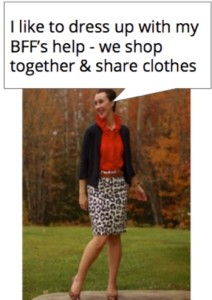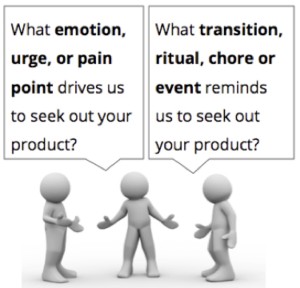Driving Re-engagement with Job Stories & Habit Stories
I had a great time at #TNWEurope sharing my thoughts on the 7 Habits that drive breakthrough innovations – and connecting with smart designers like Samuel Hulick, Mara Zepeda, and Des Traynor.
During my keynote, I discussed Job Stories as a design technique – and asked the audience to raise their hands if they’d heard of Job stories. Three people raised their hands. Out of hundreds in the room. Ooof.
Job Stories – and their superhero cousin, Habit Stories – are cutting-edge design techniques that will add speed, agility and focus to your product design efforts. It’s stunning to me that so few people know about this powerful, design-friendly shortcut for creating compelling experiences that people want and need.
Let’s fix that.
What is a Job Story?
A Job Story is a special kind of customer story – told from the customer’s POV – that follows the form shown below.

Job Stories emphasize motivation and context – and de-emphasize any particular technology or implementation. Think of Job Stories as a lighter-weight alternative to personas and scenarios for product design work.
Job Stories emerged from the Jobs-To-Be-Done movement started by Clayton Christensen et al. I first learned about Job Stories from Paul Adams of Intercom – and I’ve been using (and evolving) them since to move further, faster in my design work. For background info, please read:
- The Dribbilization of Design Paul Adams original post on Job Stories
- this excellent post by Alan Klement on Job Stories from the Intercom blog
- then practice creating a few job stories using these 5 tips
Turning customer research into design-ready insights
If you’re committed to testing your product ideas early and often with the right customers, you’ll be gathering insights at many stages of product development. Your job is to uncover the key patterns that are actually there – not just the ones you’re hoping to find – and turn those patterns into testable product hypotheses.
In practice, this means you need to quickly distill actionable results from your research. To do that, you’ll scan your data for patterns related to your product – in particular:
- existing habits that relate to your project
- unmet needs & pain points (especially around those habits)
- ideas or suggestions related to unmet needs
 Once you identify relevant patterns, you can accelerate the process by using Job Stories to turn those patterns into design-ready insights. For example, while doing customer research for a mobile fashion game, we noticed a pattern among fashion-savvy young women: a strong desire for co-operative play with one special friend or family member.
Once you identify relevant patterns, you can accelerate the process by using Job Stories to turn those patterns into design-ready insights. For example, while doing customer research for a mobile fashion game, we noticed a pattern among fashion-savvy young women: a strong desire for co-operative play with one special friend or family member.
Here’s that pattern, expressed as a quote from an early adopter that captures the key insight and emotion- and below, as a Job Story that’s setup to inform the design process.
When I
need to dress for an important event (trigger)
I want to
raid my friend’s closet & get her advice (purposeful activity)
so I can
have her accessorize my look & help me feel confident – just like she does in real life (desired outcome)
Piggyback on existing habits

In your research process, pay special attention to any existing habits your subjects reveal that are relevant to your offering. Don’t fall into the common mistake of thinking that your innovative new offering is so wonderful it’ll drive new habits. If you want to drive adoption, it’s MUCH easier to piggyback on an existing habit than to get someone to build an entirely new one.
Habits can happen daily – but also pay attention to weekly, monthly – even seasonal or yearly habits. All of those are potential hooks for habit-building and re-engagement.
What is a Habit Story?
Habit Stories are a design shortcut to help find promising opportunities for delivering customer value. A habit story is a special kind of Job Story that’s built around an existing habit paired with an unmet need. By focusing on this type of story, you’ll increase your ability to create a product experience that piggybacks on your customers’ existing habits and lifestyle- and is therefore easier to adopt and stick with.
 For example. our early research on the mobile fashion game uncovered a (habit + need) pattern among young tech-savvy fashionistas. After a long day at work, they’d kick off their heels, plop down on the couch, and flip through Vogue for some aspirational high-fashion escapism. Again and again, they mentioned how great it would be to get that same satisfaction and dose of fashion trends by playing a dress-up game.
For example. our early research on the mobile fashion game uncovered a (habit + need) pattern among young tech-savvy fashionistas. After a long day at work, they’d kick off their heels, plop down on the couch, and flip through Vogue for some aspirational high-fashion escapism. Again and again, they mentioned how great it would be to get that same satisfaction and dose of fashion trends by playing a dress-up game.
So we turned that pattern in a player quote – and also the Habit Story below, which helped us nail down one of the key features in the game – designed for this specific playstyle.
When I’m
tired after a long day & want to relax (trigger)
I want to
browse through gorgeous outfits made from the latest designer fashions (purposeful activity)
so I can
stay on top of fashion trends in a fun & relaxing way (desired outcome)
> Emotional & Situational Triggers
Emotional & Situational Triggers
Every Habit Story starts with a trigger: the cues, emotions and reminders that drive customers into a habitual behavior.
When I [trigger]
I want to [purposeful, goal-oriented action]
so I can [expected outcome]
Before building or designing anything, identify the emotions, desires, urges, or unmet needs that might drive someone to seek out your product. Then think about the situational triggers – the transitions, rituals, and events that structure someone’s daily life — and identify ones that are relevant to your project. If you start your Habit Story with powerful existing triggers, you’ll have a better shot at solving a real problem, or delighting someone when you deliver the emotional punch they’re looking for.
Quickly find the important, actionable patterns
Try out this technique the next time you’re analyzing (or preparing for) customer research. Look through your results for important, actionable patterns – and identify any that contain both an existing habit and an unmet need. Make sure to understand the emotional and situational triggers that drive the behavior – and any missing elements or friction that could be improved. Then turn those insights into Habit Stories, using the template above.
Habit Stories from your early customers will help you focus on what’s important and actionable – and create a compelling experience people will return to again and again.
Test & validate your ideas like a scientist
If you LOVE your idea, it takes supreme emotional self-control to absorb and consider feedback that contradicts your own biases. So when you’re distilling your research into Habit Stories – watch our for your own biases. Your job as a product creator is to get the most trustworthy and actionable data you can. You don’t need the advanced pattern-matching super-powers of a skilled researcher. – you just need to be scientific, open-minded and honest about what your customer data is telling you. Even when it’s hard. ESPECIALLY when it’s hard.
Getting2Alpha Spring2015 kicks off Monday May 4
If you like this approach, love smart shortcuts, and want to dramatically accelerate your product design process — check out Getting2Alpha – the fastest, smartest way to turbo-charge your path to product/market fit. Our Spring 2015 session kicks off Monday May 4. If you’re ready to move the needle on early product design – this is your rocket fuel.